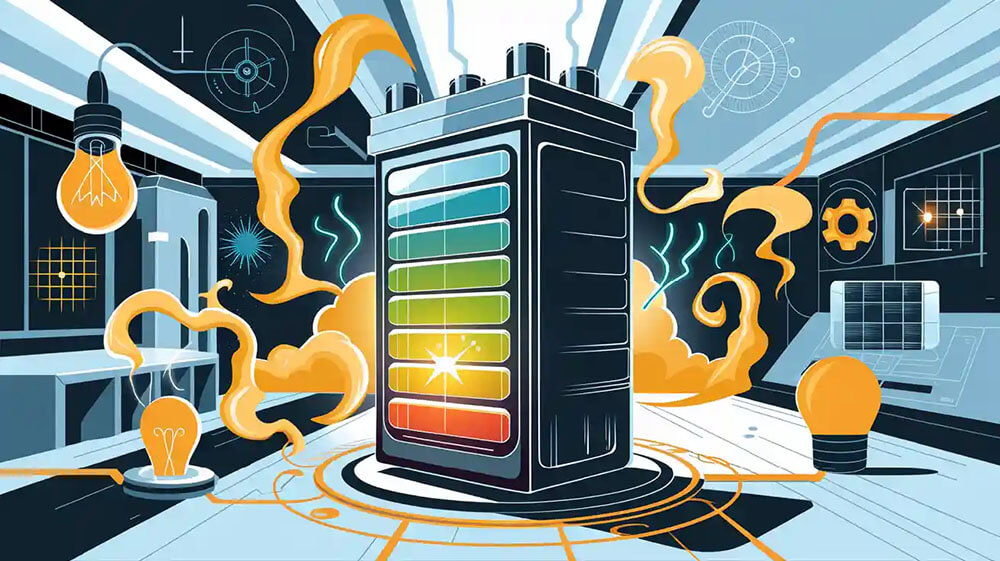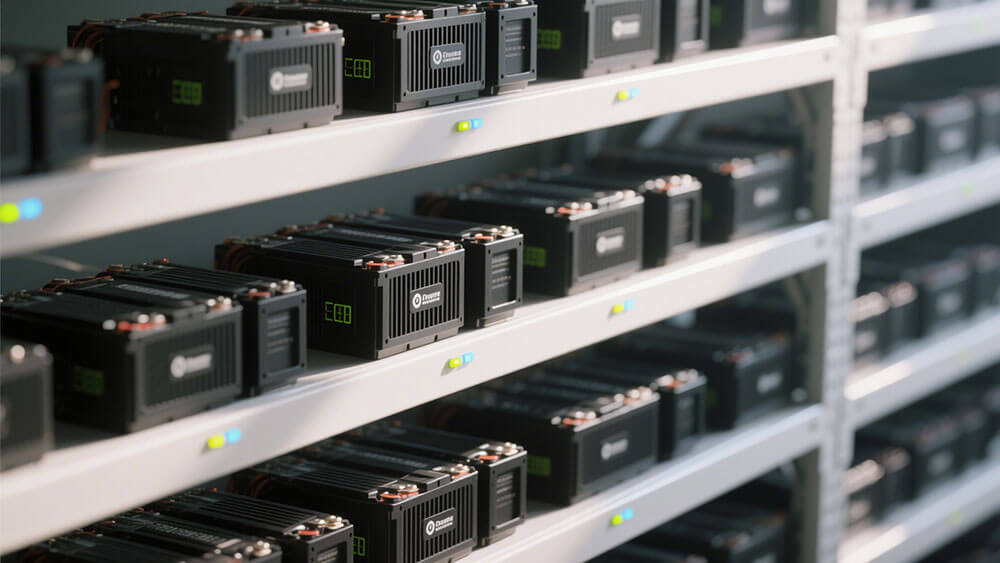
Lithium battery technology is transforming how you store and use energy. Its innovations are driving advancements across industries, from transportation to renewable energy systems. This growth reflects the increasing demand for lithium-ion batteries. In 2023, the global lithium battery market reached USD 54.4 billion, with electric vehicles emerging as a key driver.
By 2035, the lithium-ion battery energy storage system market is expected to hit $109 billion.
Over 4.4 TWh of lithium-ion energy storage systems will be installed globally within the same period.
Lithium battery trends show demand across electric vehicles and energy storage nearly doubled from 2021 to 2023.
The future of energy storage lies in the efficiency and adaptability of lithium-ion batteries, enabling sustainable solutions for modern challenges.
Key Takeaways
Lithium batteries are important for today’s industries. They power electric cars and renewable energy systems, making them more efficient and eco-friendly.
New solid-state batteries and silicon anodes are changing energy storage. They are safer, store more energy, and last longer, perfect for future use.
Recycling is key to helping the environment. It cuts waste, keeps materials available, and supports reusing resources in a circular economy.
Part 1: Current Trends in the Lithium Battery Market

1.1 The Role of Lithium Batteries in Modern Industries
Lithium battery technology has become indispensable across industries, offering unmatched versatility and performance. Its applications range from powering electric vehicles to supporting renewable energy storage systems. For instance, in cold storage, lithium-ion batteries maintain optimal performance even in low temperatures, ensuring the safety of perishable goods. Automated Guided Vehicles (AGVs) equipped with lithium batteries operate longer without frequent recharging, reducing labor costs and improving material transport efficiency.
Application | Performance Benefit | Impact on Efficiency and Sustainability |
|---|---|---|
Cold Storage | Maintains optimal performance in low temperatures | Ensures quality and safety of perishable goods |
Automated Guided Vehicles (AGVs) | Longer operational periods without frequent recharging | Reduces labor costs and improves material transport efficiency |
Energy Storage Systems | Stores excess energy from renewable sources | Maintains operational continuity and reduces downtime |
Handheld Tools and Machinery | Lightweight and portable, allowing for mobility on the manufacturing floor | Enhances productivity and reduces workflow interruptions |
Electric Vehicles (EVs) | Reduces reliance on fossil fuels and minimizes emissions | Streamlines logistics and improves delivery efficiency |
Additionally, integrating cloud-enabled telemetry technologies into lithium-ion batteries provides valuable insights. You can monitor performance, optimize energy management, and predict maintenance needs, reducing operational costs.
1.2 Market Growth Fueled by Electric Vehicles and Renewable Energy
The global lithium battery market has experienced exponential growth, driven by the adoption of electric vehicles and renewable energy systems. In 2023, global battery electric vehicle (BEV) sales reached approximately 9.5 million units, a 30% increase from 2022. The total BEV car stock worldwide now exceeds 28 million units. This surge in demand has positioned the lithium-ion battery market for electric vehicles to grow from USD 78.17 billion in 2025 to USD 205.95 billion by 2030, with a CAGR of 21.38%.
Renewable energy storage solutions also play a pivotal role in this growth. Lithium-ion batteries store excess energy from renewable sources, ensuring operational continuity and reducing downtime. This capability makes them essential for utility-scale energy storage projects, further solidifying their importance in the energy transition.
1.3 Key Market Dynamics and Emerging Trends
The lithium battery market continues to evolve, driven by advancements in technology and shifting market dynamics. The integration of lithium-ion batteries in renewable energy systems enhances energy management and reliability, fueling growth in the utility sector. Consumer electronics, particularly in emerging markets, are also driving demand due to urbanization and higher disposable incomes.
The automobile segment remains dominant, with electric vehicle adoption supported by government regulations and investments in infrastructure. As industries prioritize sustainability, the demand for high-performance batteries with longer lifespans and improved energy density continues to rise. These trends underscore the critical role of advanced lithium battery technology in shaping the future of energy storage solutions.
For businesses seeking tailored solutions, Large Power offers custom battery solutions to meet your specific needs.
Part 2: Innovations Shaping the Future of Lithium-Ion Batteries

2.1 Solid-State Batteries: Revolutionizing Energy Storage
Solid-state batteries represent a transformative leap in energy storage solutions. By replacing liquid electrolytes with solid ones, these batteries address critical challenges in safety, energy density, and longevity.
Enhanced Safety: The solid electrolyte eliminates the flammable nature of liquid electrolytes, reducing fire risks by 90%.
Higher Energy Density: These batteries can store 2-3 times more energy per unit compared to traditional lithium-ion batteries, enabling compact designs without compromising performance.
Extended Lifespan: Solid-state batteries endure 8,000 to 10,000 charge cycles, significantly outlasting conventional lithium-ion counterparts.
Recent advancements highlight the potential of solid-state batteries in reshaping the lithium battery market. For instance:
Volkswagen’s collaboration with QuantumScape has led to breakthroughs in energy density and charging speed, promising ultra-fast charging capabilities.
Samsung SDI is developing safer, faster-charging solid-state batteries tailored for electric vehicles.
Research teams at Osaka Metropolitan University are creating non-combustible solid electrolytes with superior conductivity.
Metric | Solid-State Batteries | Traditional Lithium-Ion Batteries |
|---|---|---|
Energy Density | 2-3 times more energy per unit | Lower energy density |
Charging Speed | Ultra-fast charging capabilities | Slow charging times |
Longevity | 2-5 times longer lifespan | Shorter lifespan |
Safety | 90% reduction in safety risks | Higher risk of hazards |
Weight | Lighter, improving efficiency | Heavier, impacting performance |
These advancements position solid-state batteries as a cornerstone of next-generation battery technologies, offering unparalleled benefits for industries like electric vehicles and renewable energy storage.
2.2 Silicon Anodes: Boosting Energy Density and Performance
Silicon anodes are redefining the performance benchmarks of lithium-ion batteries. By replacing traditional graphite anodes, silicon offers a theoretical capacity of nearly 3600 mAh/g, which is 10 times higher than graphite’s 360 mAh/g. This innovation enables cell-level energy densities exceeding 400 Wh/kg and 1000 Wh/l, nearly doubling the energy density of current commercial cells.
Key developments in silicon anode technology include:
Group14 Technologies’ EV-scale silicon anode materials plant in Korea, producing 2,000 metric tons annually to enhance battery performance.
ATL’s deployment of silicon anode batteries in millions of smartphones, showcasing real-world applications.
Archer’s use of silicon anode technology in air taxis, demonstrating its potential in advanced transportation solutions.
Recent advancements have also addressed the swelling issue of silicon anodes, which previously limited their practicality. Techniques like two-dimensional covalent encapsulation and silicon-carbon hybrids have improved capacity and rate capability, making silicon anodes a viable option for high-performance batteries.
2.3 Recycling Technologies: Advancing Circular Economy Goals
Recycling technologies are critical for achieving sustainability in the lithium battery market. Advanced recycling processes not only reduce environmental impact but also recover valuable materials for reuse, supporting a circular economy.
Hydrometallurgical recycling processes can cut greenhouse gas emissions by 90% compared to traditional mining.
Electric vehicle batteries retain significant value when repurposed, making them ideal candidates for recycling.
The EU aims to recycle up to 70% of lithium by 2030, enhancing resource efficiency.
Metric | Recycling Process | Mining Process |
|---|---|---|
Greenhouse Gas Emissions | < 50% of mining | 100% |
Water Use | 25% of mining | 100% |
Energy Use | 25% of mining | 100% |
Scrap Stream GHG Emissions | 19% of mining | 100% |
Scrap Stream Water Use | 12% of mining | 100% |
Scrap Stream Energy Use | 11% of mining | 100% |
Recycling facilities, described as “perfect mines” by industry experts, offer lower costs and environmental footprints compared to primary mining. Techniques like sieving, magnetic separation, and flotation further enhance recycling efficiency. These sustainable practices align with global efforts to reduce waste and promote renewable energy storage.
For more on sustainability initiatives, visit sustainability at Large Power.
2.4 Cathode Chemistry Advancements: Enhancing Battery Efficiency
Advancements in cathode chemistry have significantly improved the efficiency and performance of lithium-ion batteries. The transition from simple oxide cathodes to complex structures, such as layered oxides, spinel oxides, and polyanion oxides, has enabled higher operating voltages and energy densities.
These materials allow for higher oxidation states of transition-metal ions, increasing operational voltage and energy output. For example, NMC Lithium batteries (nickel-cobalt-manganese) now achieve energy densities of 160-270 Wh/kg with a cycle life of 1,000-2,000 cycles. Similarly, LiFePO4 Lithium batteries offer exceptional cycle life, ranging from 2,000 to 5,000 cycles, making them ideal for renewable energy storage and electric vehicles.
Cathode chemistry advancements continue to drive the development of high-performance batteries, ensuring the lithium battery market remains at the forefront of energy storage innovation.
For custom battery solutions tailored to your needs, explore Large Power’s offerings.
Part 3: Challenges Addressed by Lithium Battery Innovations

3.1 Environmental Sustainability and Resource Management
The lithium battery market faces increasing scrutiny over its environmental impact. Innovations in lithium-ion batteries are addressing these concerns by optimizing designs and improving resource management strategies. These advancements reduce the ecological footprint of battery production and usage, aligning with global sustainability goals.
Optimized lithium-ion battery designs have reduced resource depletion by 23.5%, cutting it from 85 kg Sb eq to 65 kg Sb eq.
Global warming potential has decreased by 20%, dropping from 100 kg CO2 eq to 80 kg CO2 eq.
Toxicity levels have improved by 21.4%, with reductions from 70 CTUh to 55 CTUh.
Water usage and energy consumption have both decreased by 16.7%, from 60 m³ to 50 m³ and 90 MJ to 75 MJ, respectively.
In addition to design improvements, sustainable resource management strategies are transforming the battery market:
Sustainable raw material sourcing: Ethical mining practices ensure responsible extraction of lithium and cobalt.
Renewable energy integration: Manufacturing facilities are increasingly powered by solar and wind energy.
Energy efficiency: Advanced technologies optimize production processes, reducing energy consumption.
Battery recycling: Efficient recycling infrastructure enables the recovery of valuable materials, minimizing waste.
Governmental policies: Regulations promote responsible sourcing and emissions reduction, fostering a greener industry.
These efforts not only enhance the sustainability of lithium-ion batteries but also support renewable energy storage systems. By adopting these practices, you can contribute to a circular economy while meeting the growing battery demand.
3.2 Overcoming Supply Chain Bottlenecks
The rapid growth of the lithium battery market has exposed vulnerabilities in the supply chain. Rising demand for electric vehicles and renewable energy storage has intensified the need for critical materials like lithium and cobalt. Recycling processes and sustainability-focused innovations are key to addressing these challenges.
Recycling plays a pivotal role in mitigating supply chain risks. By recovering materials from used batteries, you can reduce dependence on primary mining and ensure a steady supply of resources. This approach not only lowers costs but also minimizes environmental impact.
Technological advancements further enhance supply chain resilience. For example, solid-state batteries require fewer raw materials, reducing reliance on scarce resources. Additionally, research into alternative materials and battery chemistries diversifies supply options, ensuring stability in the face of market fluctuations.
As the battery market evolves, prioritizing sustainability and innovation will help you navigate supply chain challenges effectively. These strategies ensure the availability of high-performance batteries for energy storage solutions and other applications.
3.3 Addressing Market Volatility and Cost Pressures
Market volatility and cost pressures remain significant challenges in the lithium-ion battery industry. Innovations in production processes and strategic policies are helping to stabilize the market and reduce costs.
Evidence Description | Type of Evidence |
|---|---|
The PRC’s strategic use of subsidies and investments has established it as a dominant force in the global EV industry. | Strategic investment and subsidies |
The Inflation Reduction Act of 2022 added regulations to subsidize lithium from North American refiners for use in EVs. | Government policy and subsidies |
Increasing reliance on domestic industry and securing recycled lithium sources offer viable solutions to mitigate supply risks. | Supply chain resilience strategies |
Government policies, such as the Inflation Reduction Act of 2022, incentivize the use of domestically refined lithium, reducing reliance on foreign sources. These measures stabilize the lithium-ion battery market and encourage investment in local industries.
Recycling also plays a crucial role in addressing cost pressures. By reusing materials, manufacturers can lower production expenses and reduce exposure to price volatility in raw material markets. This approach ensures the affordability of lithium-ion batteries for applications like renewable energy storage and electric vehicles.
By leveraging these strategies, you can overcome market challenges and capitalize on the growing demand for energy storage solutions. For tailored battery solutions, explore Large Power’s custom offerings.
The lithium battery market continues to evolve with groundbreaking innovations and strategic solutions addressing critical challenges. Technologies like solid-state batteries and silicon anodes are redefining energy density and safety standards. Recycling advancements and cathode chemistry improvements further enhance sustainability and efficiency.
Aspect | Details |
|---|---|
Innovations | Solid-state and lithium-metal batteries with higher energy densities. |
Challenges | Resource scarcity, safety risks, and thermal instability. |
Strategies for Improvement | Advanced cathode materials and electrolyte additives to boost performance. |
Applications | Electric vehicles, smartphones, and portable electronics. |
Limitations | Dendrite growth in new battery types and the need for sustainable energy storage solutions. |
To meet growing demand, you must prioritize sustainability and supply chain resilience. These advancements hold transformative potential for industries and the global energy landscape. Explore custom battery solutions from Large Power to stay ahead in this dynamic market.
FAQ
1. What makes solid-state batteries safer than traditional lithium-ion batteries?
Solid-state batteries use non-flammable electrolytes, reducing fire risks by 90%. Their design eliminates thermal instability, ensuring safer energy storage for electric vehicles and electronics.
Tip: For professional guidance on solid-state-batteries, visit Large Power.
2. How does recycling improve the lithium battery market?
Recycling recovers valuable materials, reduces environmental impact, and minimizes reliance on mining. It supports sustainability goals and stabilizes supply chains for battery production.
3. Can silicon anodes increase battery performance?
Silicon anodes offer 10x higher capacity than graphite, doubling energy density. Advanced designs prevent swelling, ensuring durability for electric vehicles and portable devices.






